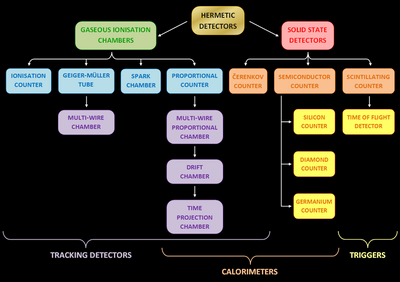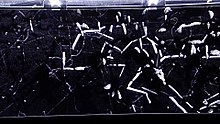Particle detector
In experimental and applied particle physics, nuclear physics, and nuclear engineering, a particle detector, also known as a radiation detector, is a device used to detect, track, and/or identify ionizing particles, such as those produced by nuclear decay, cosmic radiation, or reactions in a particle accelerator. Detectors can measure the particle energy and other attributes such as momentum, spin, charge, particle type, in addition to merely registering the presence of the particle.
Contents
1 Examples and types
2 Modern detectors
3 Research particle detectors
3.1 At colliders
3.2 Under construction
3.3 Without colliders
4 On spacecraft
5 See also
6 References
7 Further reading
Examples and types

Summary of Particle Detector types
Many of the detectors invented and used so far are ionization detectors (of which gaseous ionization detectors and semiconductor detectors are most typical) and scintillation detectors; but other, completely different principles have also been applied, like Čerenkov light and transition radiation.

Cloud chambers visualize particles by creating a supersaturated layer of vapor. Particles passing through this region create cloud tracks similar to condensation trails of planes

Recording of a bubble chamber at CERN
Historical examples
- Bubble chamber
- Wilson cloud chamber (diffusion chamber)
- Photographic plates
Detectors for radiation protection
The following types of particle detector are widely used for radiation protection, and are commercially produced in large quantities for general use within the nuclear, medical and environmental fields.
Gaseous ionization detectors
- Geiger-Müller tube
- Ionization chamber
- Proportional counter
- Scintillation counter
- Semiconductor detectors
- Dosimeters
Electroscopes (when used as portable dosimeters)
Commonly used detectors for particle and nuclear physics
Gaseous ionization detectors
- Ionization chamber
Proportional counter
- Multiwire Proportional Chamber
- Drift chamber
- Time projection chamber
- Geiger-Müller tube
- Spark chamber
Solid-state detectors
semiconductor detectors and variants including CCDs
- solid-state track detectors
Cherenkov detector
- RICH (Ring Imaging Cherenkov Detector)
Scintillation counter and associated Photomultiplier or Photodiode / Avalanche photodiode
- Lucas cell
- Time of flight detector
Semiconductor detector
- Silicon Vertex Detector
- Transition radiation detector
- Calorimeters
- Microchannel plate detectors
- Neutron detectors
Modern detectors
Modern detectors in particle physics combine several of the above elements in layers much like an onion.
Research particle detectors
Detectors designed for modern accelerators are huge, both in size and in cost. The term counter is often used instead of detector when the detector counts the particles but does not resolve its energy or ionization. Particle detectors can also usually track ionizing radiation (high energy photons or even visible light). If their main purpose is radiation measurement, they are called radiation detectors, but as photons are also (massless) particles, the term particle detector is still correct.
At colliders
- At CERN
- for the LHC
- CMS
- ATLAS
- ALICE
- LHCb
- for the LEP
Aleph[1]
Delphi[2]
- L3
Opal[3]
- for the SPS
- The COMPASS Experiment
- Gargamelle
- NA61/SHINE
- for the LHC
- At Fermilab
- for the Tevatron
- CDF
- D0
- Mu2e
- for the Tevatron
- At DESY
- for HERA
- H1
- HERA-B
- HERMES
- ZEUS
- for HERA
- At BNL
- for the RHIC
- PHENIX
- Phobos
- STAR
- for the RHIC
- At SLAC
- for the PeP-II
- BaBar
- for the SLC
- SLD
- for the PeP-II
- At Cornell
- for CESR
- CLEO
- CUSB
- for CESR
- At BINP
- for the VEPP-2M and VEPP-2000
- ND
- SND
- CMD
- for the VEPP-4
- KEDR
- for the VEPP-2M and VEPP-2000
- Others
MECO from UC Irvine
Under construction
- For ILC
- CALICE
Without colliders
- Super-Kamiokande
- AMANDA
- CDMS
On spacecraft
- JEDI
- AMS
See also
- List of particles
- Counting efficiency
References
Jones, R. Clark (1949). "A New Classification System for Radiation Detectors". Journal of the Optical Society of America. 39 (5): 327–341. doi:10.1364/JOSA.39.000327..mw-parser-output cite.citation{font-style:inherit}.mw-parser-output q{quotes:"""""""'""'"}.mw-parser-output code.cs1-code{color:inherit;background:inherit;border:inherit;padding:inherit}.mw-parser-output .cs1-lock-free a{background:url("//upload.wikimedia.org/wikipedia/commons/thumb/6/65/Lock-green.svg/9px-Lock-green.svg.png")no-repeat;background-position:right .1em center}.mw-parser-output .cs1-lock-limited a,.mw-parser-output .cs1-lock-registration a{background:url("//upload.wikimedia.org/wikipedia/commons/thumb/d/d6/Lock-gray-alt-2.svg/9px-Lock-gray-alt-2.svg.png")no-repeat;background-position:right .1em center}.mw-parser-output .cs1-lock-subscription a{background:url("//upload.wikimedia.org/wikipedia/commons/thumb/a/aa/Lock-red-alt-2.svg/9px-Lock-red-alt-2.svg.png")no-repeat;background-position:right .1em center}.mw-parser-output .cs1-subscription,.mw-parser-output .cs1-registration{color:#555}.mw-parser-output .cs1-subscription span,.mw-parser-output .cs1-registration span{border-bottom:1px dotted;cursor:help}.mw-parser-output .cs1-hidden-error{display:none;font-size:100%}.mw-parser-output .cs1-visible-error{font-size:100%}.mw-parser-output .cs1-subscription,.mw-parser-output .cs1-registration,.mw-parser-output .cs1-format{font-size:95%}.mw-parser-output .cs1-kern-left,.mw-parser-output .cs1-kern-wl-left{padding-left:0.2em}.mw-parser-output .cs1-kern-right,.mw-parser-output .cs1-kern-wl-right{padding-right:0.2em}
Jones, R. Clark (1949). "Erratum: The Ultimate Sensitivity of Radiation Detectors". Journal of the Optical Society of America. 39 (5): 343. doi:10.1364/JOSA.39.000343.
Jones, R. Clark (1949). "Factors of Merit for Radiation Detectors". Journal of the Optical Society of America. 39 (5): 344–356. doi:10.1364/JOSA.39.000344.
Further reading
- Filmstrips
- "Radiation detectors". H. M. Stone Productions, Schloat. Tarrytown, N.Y., Prentice-Hall Media, 1972.
- General Information
Grupen, C. (June 28 – July 10, 1999). "Physics of Particle Detection". AIP Conference Proceedings, Instrumentation in Elementary Particle Physics, VIII. 536. Istanbul: Dordrecht, D. Reidel Publishing Co. pp. 3&ndash, 34. arXiv:physics/9906063. doi:10.1063/1.1361756.